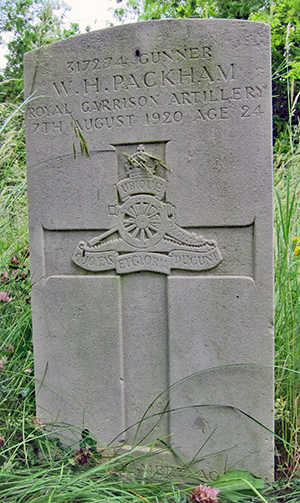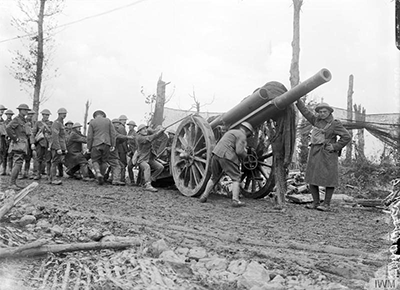First World War Project
William Henry PACKHAM (of Lynsted)
b. Q2, 1896 Gunner, Service Number 317274 |

"TILL WE MEET AGAIN"
William is the last Lynsted casualty of the First World War, dying as a result of wounds received in war service before the official cut-off date of 31 August 1921. We know that it was not uncommon for lives to be cut short from the effects of gassing etc. No doubt others will have succumbed after the cut-off date for official remembrance.
Born in Bordon in the second quarter of 1896, William was the oldest child of George Henry, a farm carter originally from Bapchild, and Alice Amelia (née Steers) originally from Canterbury. At the time of the 1901 Census, William was living at Key Street, Borden, along with two younger siblings, George and Leonard. By the time of the 1911 Census, the family had moved to Ivy Cottage, Norton and there was an addition to the family, a sister, Alice. William was working as a farm labourer.
Few of William's records are available. Although we do not know when William joined up, legally he would not have been old enough to have embarked for active service until 28 December 1915.
 We know he served in the 1st/1st Home Counties (Kent) Heavy Battery, Royal Garrison Artillery (Territorial Force). The Heavy Batteries were in charge of the heavy 60 pounder (5 inch) guns, firing high explosive shells. They were most often employed in destroying enemy artillery and strategic targets behind enemy lines.
We know he served in the 1st/1st Home Counties (Kent) Heavy Battery, Royal Garrison Artillery (Territorial Force). The Heavy Batteries were in charge of the heavy 60 pounder (5 inch) guns, firing high explosive shells. They were most often employed in destroying enemy artillery and strategic targets behind enemy lines.
Upon mobilisation in Aug 1914, William's battery was part of the 44th (Home Counties) Division. Based at first in the UK, it took up position at the defensive forts on the south coast.
The battery joined 2nd Home Counties Division on 30 October 1915 and moved to billets near Windsor. On 17 November 1915 the battery began to equip for posting abroad. They embarked for Le Havre on 28 December 1915, arriving the following day. Two days later the Battery joined the 16th Heavy Brigade, RGA.
On 25 April 1916, they transferred to the 48th Heavy Artillery Group (HAG) and began their preparations for the beginning of the Battle of the Somme. On the days preceding the battle, the battery was engaged in bombardment of the surrounding German-held villages. Sadly their accuracy was poor. Of 30 shells fired, just 3 were on target. With the postponement of the battle due to poor weather, the Battery continued firing but at a significantly lower rate than was possible and wide of the target.
At 6.25am on 1 July 1916, the Battery took part in a 65 minute bombardment of the German front.
At 07.30am the infantry battalions went over the top while the heavy guns moved to fire onto William Henry Packham.
German support and reserve lines in an effort to suppress the German artillery. Although this action engaged a large number of German batteries, it was reported that they had little affect. By the end of this first day of the Somme, although slight gains had been made, these had to be abandoned after dark.
Over the next two years, the 1/1st Kent Battery remained with the 92nd Brigade, now renamed the 92nd (Mobile) Brigade.
We know that William was serving "somewhere in France" at the beginning of 1918 as he was one of the men from Lynsted and Teynham who sent a note of thanks for the Christmas gifts received from villagers at home. His thanks were published in the Faversham and North East Kent News on 19 January 1918:
W. Packham:- "Thank you for the magnificent smokes; they are the best I have smoked...Let us all hope that this year is the year of victory."
At the start of the German Spring Offensive on 21 March 1918, William's Brigade went to the support of the Third Army, with which they would remain until the end of the war. After the collapse of the offensive on 18 July 1918, the Allied forces went on the attack with the Hundred Day Offensive (8 August - 11 November 1918). William's Brigade was assigned to support the attacks during the Battle of Cambrai-St Quentin (27 September– 19 October).
As the war dragged to its end, the 92nd Brigade were again attached to IV Corps Artillery for the Battle of the River Selle (17 - 25 October 1918). Finally they were called in to support the 37th Division and the New Zealand Division in capturing the old fortress of Le Quesnoy during the Battle of the Sambre on 4 November 1918.
In January 1920, William was awarded the British War and Victory medals. [Appendix 1]
We have found no records that pinpoint when or where William received the injuries that would eventually lead to his death from peritonitis on 7 August 1920. At this time William was living at home with his parents at 92 London Road, Lynsted.

 World War 1 Pages
World War 1 Pages